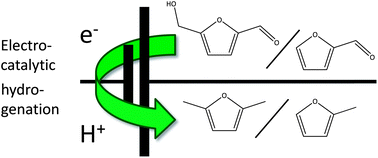Researchers at TU Braunschweig under the direction of Professor Uwe Schröder have demonstrated highly selective electrochemical hydrogenation of two furanics, common biomass derivatives.
Chemical hydrogenation of biomass substrates can be a difficult prospect. High pressures of H2 at high temperature would make any chemist with a reasonable expectation of longevity understandably squeamish. According to research from the University of Technology at Braunschweig, a potentiostat may be the organic chemist’s best friend.
In their recent article in EES, the authors, Schröder and Nilges, demonstrate the electrochemical conversion of furfural and 5-hydroxymethylfurfural to 2-methylfuran and 2,5-dimethylfuran, respectively. These substrates are derived from lignocellulosic biomass or from polysaccharides such as cellulose and starch. By demonstrating selective electroorganic reduction at copper and lead electrodes, this work opens the possibility of inexpensive electrochemical reactors that could improve the value of biomass-derived compounds.
One main problem is the competing hydrogen evolution reaction (HER). This is a common hurdle for reductive electrochemistry on most electrode surfaces and can severely limit Faradaic efficiency. The authors report that for this system, running high concentrations (500 mM) of substrate can reduce percentage of electrons lost to HER. While this presents a challenge for scaling-up, these products actually separate from the aqueous electrolyte solution, forming another phase that is relatively easy to remove.
Looking to the future, this work represents an intriguing combination of renewable energy strategies – using renewable sources of energy to convert biomass to more useful or at least more energy dense chemicals. Certainly, the energy future poses some daunting challenges that resist any single silver bullet. By combining renewable energy storage with biofuel substrates, some challenging steps in both fields might be avoidable.
By Michael Doud
Read the article in EES:
Electrochemistry for biofuel generation: production of furans by electrocatalytic hydrogenation of furfurals
Peter Nilges and Uwe Schröder
DOI: 10.1039/C3EE41857J, Communication











